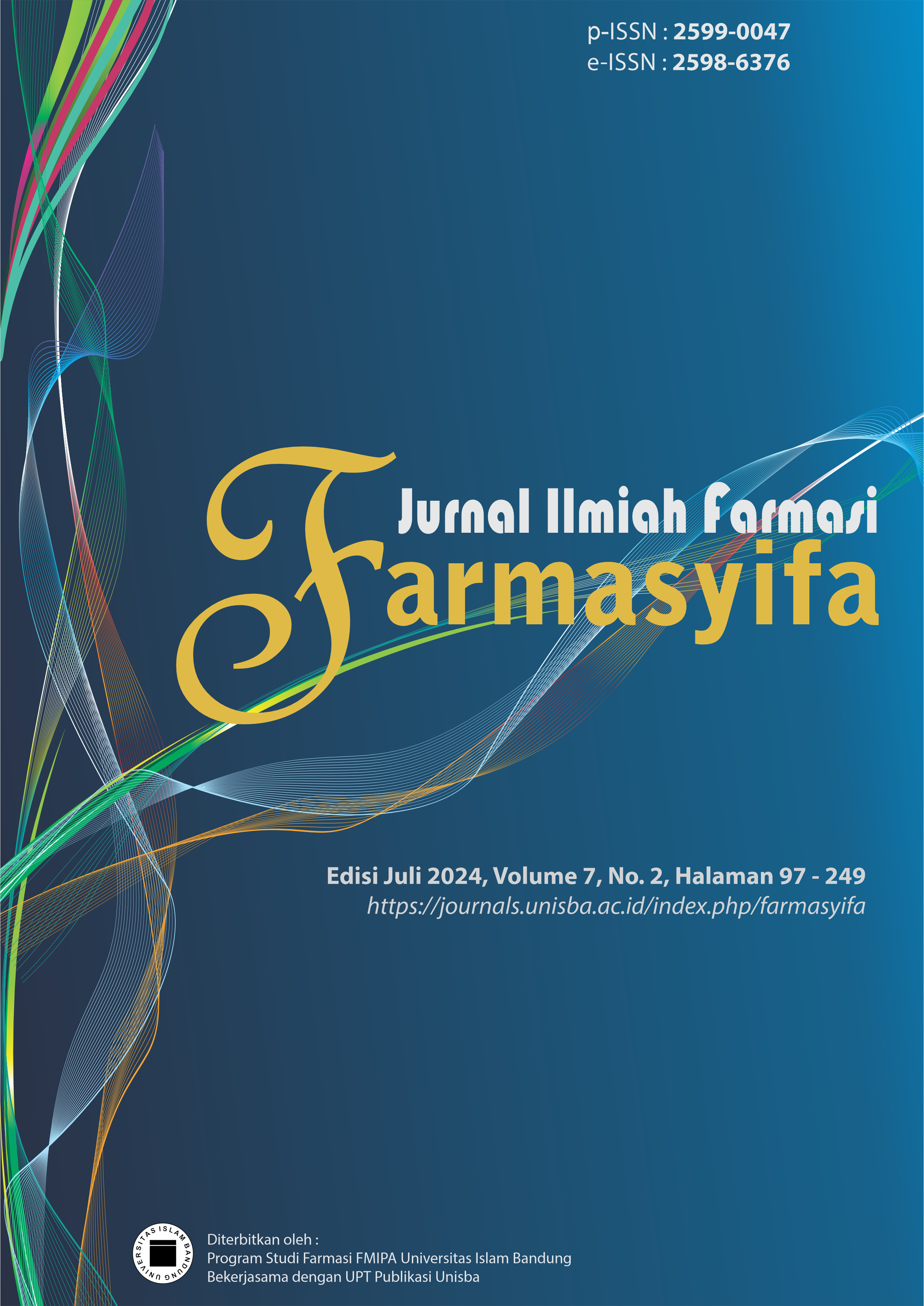THE INFLUENCE OF THE DRYING METHOD ON POLYPHENOL LEVELS AND TOTAL FLAVONOIDS IN ARABICA COFFEE BEANS (Coffea arabica L.) ARJASARI
PENGARUH METODE PENGERINGAN TERHADAP KADAR POLIFENOL DAN FLAVONOID TOTAL PADA BIJI KOPI ARABIKA (Coffea arabica L.) ARJASARI
DOI:
https://doi.org/10.29313/jiff.v7i2.3804Keywords:
biji kopi Arabika, Coffea arabica L. polivenol, flavonoid, pengeringan kopi, pascapanenAbstract
Polyphenolic compounds and flavonoids are secondary metabolite compounds that are most found in plants and have various pharmacological effects, one of which is as an antioxidant. These two secondary metabolite compounds are also contained in coffee beans. Post-harvest handling of cherry coffee cherries into coffee beans is carried out through natural, semi-washed and full-washed processes. These three processes can affect the taste of coffee beans. This research aims to see the effect of the post-harvest processing of Arabica coffee fruit (Coffea arabica L.) into green coffee beans on total polyphenol and flavonoid levels. Tests were carried out on the ethanol extract of green coffee beans. The results of measuring the polyphenol content of the ethanol extract of green coffee beans showed that the total polyphenol content was highest in full-washed coffee beans (BKfw) at 116.71 mg GAE/g extract, while the total polyphenol content of the ethanol extract of semi-washed coffee beans (BKsw) and Full-washed Coffee Beans (BKfw) are 115.70 mg GAE/g extract and 103.60 mg GAE/g extract, respectively. The drying process affected polyphenol levels and was statistically significantly different. The results of measuring the total flavonoid content of the ethanol extract of Natural Arabica (BKn), semi-washed (BKsw) and full washed (BKfw) coffee beans were 5.67 mgQE/g, 6.28 mgQE/g, and 5.56 mgQE/g, respectively. g. These results did not show a significant difference, so the drying process had no effect on flavonoid levels.
References
Ahmad, A.R., Juwita, S.A.D. Ratulangi dan A. Malik. (2015). Penetapan Kadar Fenolik dan Flavonoid Total Ekstrak Metanol Buah dan Daun Patkala (Etlingera elatior (Jack) n R.M.SM). Pharm Sci Res. April 2015. Vol.2 No.1)
Chang, C. C., Yang, M. H., Wen, H. M., Chern, J. C., (2002). Estimation of total flavonoid content in propolis by two complementary colorimetric methods. J Food Drug Ana. (10).
De Bruyn F, Zhang SJ, Pothakos V, Torres J, Lambot C, Moroni AV, Callanan M, Sybesma W, Weckx S, De Vuyst L. (2017).Exploring the Impacts of Postharvest Processing on the Microbiota and Metabolite Profiles during Green Coffee Bean Production. Appl Environ Microbiol 83: e02398-16. https://doi.org/10.1128/AEM.02398-16
Eshetu, E. F., Tolassa, K., Mohammed, A., Berecha, G. & Garedew, W. (2022) Effect of processing and drying methods on biochemical composition of coffee (Coffea arabica L.) varieties in Jimma Zone, Southwestern Ethiopia. Cogent Food & Agriculture, 8:1, 2121203, DOI: 10.1080/23311932.2022.2121203.
Kathurima, C.W., G.M. Kenji, S.N. Muhoho, R. Boulanger and F. Davrieux, (2010). Discrimination of Coffea arabica Hybrids of the Composite Cultivar Ruiru 11 by Sensorial Evaluation and Biochemical Characterization. Advance Journal of Food Science and Technology 2(3): 148-154,
Hudakova, J., D. Marcincakova and J. Legath. (2016). Studi Of Antioxidants Effects Of Selected types Of Coffee. Folia Veterinaria, 60, 3:34, 34-38.
Selmar, D., M. Kleinwachter, and G. Bytof. (2016). Metabolic Responses of Coffee Beans During Processing and Their Impact on Coffee Flavour.
Sunarharum, W.B., S.S. Yuwono, N.B.S.W Pangestu and H. Nadhiroh. (2018). Physical and sensory quality of Java Arabica green coffee beans. International Conference on Green Agro-industry and Bioeconomy. 131. 012018.
Várady, M., Tauchen, J., Fraňková, A., Klouček, P., Popelka, P. (2022). Effect of method of processing specialty coffee beans (natural, washed, honey, fermentation, maceration) on bioactive and volatile compounds, LWT, 172, 114245, ISSN 0023-6438.
Yamagata K. (2018) Do Coffee Polyphenols Have a Preventive Action on Metabolic Syndrome Associated Endothelial Dysfunctions? An Assessment of the Current Evidence. Antioxidants (Basel). 4;7(2):26. doi: 10.3390/antiox7020026. PMID: 29401716; PMCID: PMC5836016.
Downloads
Published
How to Cite
Issue
Section
License
Copyright (c) 2024 Siti Hazar, Esti R. Sadiyah, Reza Abdul Kodir

This work is licensed under a Creative Commons Attribution-ShareAlike 4.0 International License.






















